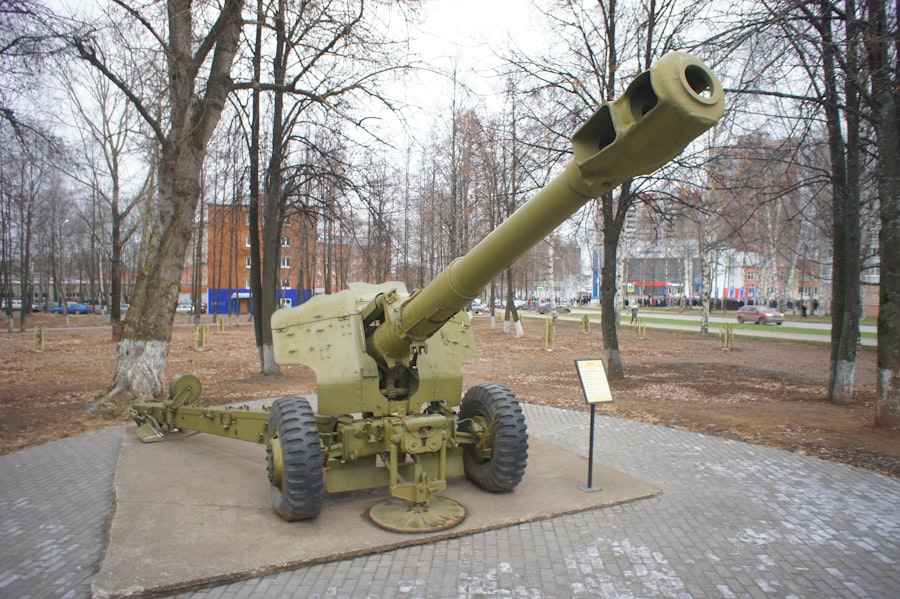The Cold War, a period marked by intense geopolitical tension between the United States and the Soviet Union, was characterized by an arms race that defined international relations for decades. This competition was not merely about military might; it was a struggle for ideological supremacy, technological advancement, and global influence. As both superpowers sought to outdo each other, they poured vast resources into developing their military arsenals, particularly nuclear weapons and delivery systems.
The arms race was fueled by a pervasive fear of mutual destruction, leading to an environment where both sides felt compelled to continuously enhance their capabilities. The stakes were incredibly high during this period, as the threat of nuclear war loomed large over the world. Each nation sought to establish a credible deterrent against the other, leading to the stockpiling of weapons and the development of sophisticated delivery systems.
The Cold War arms race was not just a military endeavor; it was also a psychological battle, with each side attempting to project strength and resolve. The competition extended beyond mere numbers; it involved technological innovation, strategic positioning, and the ability to respond to perceived threats. This relentless pursuit of military superiority would shape global politics for generations to come.
Key Takeaways
- The Cold War Arms Race led to a competition between the United States and the Soviet Union to develop and stockpile advanced weapons.
- The Soviet Union’s Missile Program was a key component of their military strategy during the Cold War, leading to the development of advanced missile capabilities.
- Unveiling the Arsenal: A Look at Soviet Missile Capabilities reveals the extent of the Soviet Union’s missile arsenal and its potential impact on global politics.
- The Role of Missile Technology in Soviet Military Strategy highlights the importance of missile capabilities in shaping the Soviet Union’s approach to warfare and defense.
- The Impact of Soviet Missile Capabilities on Global Politics was significant, as it influenced the balance of power and international relations during the Cold War era.
The Soviet Union’s Missile Program
The Soviet Union’s missile program emerged as a cornerstone of its military strategy during the Cold War. Initially focused on developing short-range ballistic missiles, the program rapidly evolved to include intermediate and intercontinental ballistic missiles (ICBMs). The Soviet leadership recognized that missile technology would be crucial in establishing a credible deterrent against Western powers.
As a result, significant investments were made in research and development, leading to rapid advancements in missile capabilities. By the late 1950s, the Soviet Union had successfully launched its first intercontinental ballistic missile, marking a significant milestone in its military history. This achievement not only showcased the technological prowess of the Soviet Union but also sent shockwaves through the West.
The ability to strike targets across vast distances fundamentally altered the strategic landscape, compelling Western nations to reassess their own military capabilities and strategies. The Soviet missile program became a symbol of national pride and a key element of its foreign policy, as it sought to project power and influence on the global stage.
Unveiling the Arsenal: A Look at Soviet Missile Capabilities

The capabilities of the Soviet missile arsenal were both impressive and alarming. By the 1960s, the Soviet Union had developed a range of missile systems that could deliver nuclear warheads with remarkable accuracy and speed. The R-7 Semyorka, the world’s first ICBM, was capable of reaching targets in the United States from launch sites in the Soviet Union.
This missile was followed by a series of increasingly sophisticated systems, including the R-16 and R-36, which further enhanced the range and payload capacity of Soviet missiles. In addition to ICBMs, the Soviet Union also developed intermediate-range ballistic missiles (IRBMs) and submarine-launched ballistic missiles (SLBMs). These systems provided the Soviet military with a diverse array of options for delivering nuclear weapons, complicating Western defense strategies.
The sheer scale of the Soviet missile program was staggering; by the late 1970s, estimates suggested that the USSR possessed thousands of nuclear warheads and delivery vehicles. This extensive arsenal not only posed a direct threat to Western nations but also contributed to an atmosphere of fear and uncertainty that permeated global politics.
The Role of Missile Technology in Soviet Military Strategy
| Aspect | Metrics |
|---|---|
| Number of Missiles | Thousands of ballistic and cruise missiles deployed |
| Range of Missiles | Short, medium, and intercontinental ranges |
| Accuracy | Improvements in targeting and precision |
| Deployment | Land, sea, and air-based missile systems |
| Strategic Importance | Integral part of deterrence and defense strategy |
Missile technology played a pivotal role in shaping Soviet military strategy during the Cold War. The leadership understood that possessing advanced missile capabilities would not only serve as a deterrent but also provide leverage in international negotiations.
Moreover, missile technology was integrated into broader military doctrines that emphasized rapid response and flexibility.
This reliance on missile technology influenced not only military planning but also diplomatic efforts, as both superpowers engaged in negotiations aimed at limiting nuclear arms while simultaneously seeking to maintain their strategic advantages.
The Impact of Soviet Missile Capabilities on Global Politics
The emergence of sophisticated Soviet missile capabilities had profound implications for global politics during the Cold War. The balance of power shifted as both superpowers sought to establish dominance through their respective arsenals. The presence of ICBMs and other advanced missile systems created a precarious situation where any miscalculation could lead to catastrophic consequences.
This reality underscored the importance of diplomacy and arms control agreements as nations grappled with the potential for nuclear conflict. Soviet missile capabilities also influenced regional conflicts and alliances around the world. Nations aligned with either superpower often found themselves caught in the crossfire of this geopolitical struggle.
The Cuban Missile Crisis of 1962 exemplified how close the world came to nuclear war due to misunderstandings and miscalculations related to missile deployments. As both sides navigated this treacherous landscape, the need for effective communication and negotiation became increasingly apparent.
The Development of Intercontinental Ballistic Missiles (ICBMs)

The development of intercontinental ballistic missiles (ICBMs) marked a significant turning point in military technology and strategy during the Cold War. The Soviet Union’s early successes in this area set off alarm bells in Washington, prompting an urgent response from American defense planners. ICBMs represented a leap forward in terms of range and destructive capability, allowing for rapid strikes against distant targets with little warning.
The R-7 Semyorka, introduced in 1957, was a groundbreaking achievement that demonstrated the feasibility of long-range missile technology. Subsequent models, such as the R-16 and R-36, built upon this foundation, incorporating advancements in guidance systems and payload capacity. As these missiles became operational, they fundamentally altered the strategic calculus for both superpowers, leading to an escalation in arms development efforts on both sides.
The Threat of Soviet Missile Capabilities to Western Powers
The threat posed by Soviet missile capabilities was a constant concern for Western powers throughout the Cold War. As the USSR expanded its arsenal and refined its delivery systems, fears grew that a surprise attack could occur at any moment. This anxiety was exacerbated by incidents such as the Cuban Missile Crisis, which highlighted how quickly tensions could escalate into open conflict.
Western nations responded by investing heavily in their own missile programs and developing countermeasures aimed at mitigating the threat posed by Soviet missiles. This included advancements in missile defense systems and efforts to enhance early warning capabilities. However, despite these measures, the specter of nuclear annihilation loomed large over international relations, creating an atmosphere of distrust and hostility that defined much of the era.
Soviet Missile Capabilities and the Space Race
The development of missile technology was closely intertwined with the Space Race, as both superpowers sought to demonstrate their technological superiority through achievements in space exploration. The launch of Sputnik in 1957 not only marked a significant milestone in space exploration but also showcased the capabilities of Soviet missile technology. This event sent shockwaves through America, prompting an urgent reassessment of its own technological capabilities.
As both nations raced to achieve milestones in space exploration, advancements in missile technology played a crucial role in their respective efforts. The same technologies that enabled long-range missile strikes were also applicable to launching satellites and crewed missions into space. This dual-use nature of missile technology underscored its importance not only for military strategy but also for national prestige on the global stage.
The Legacy of Soviet Missile Capabilities in Modern Warfare
The legacy of Soviet missile capabilities continues to influence modern warfare and international relations today. Many nations have drawn lessons from the Cold War arms race, leading to ongoing debates about nuclear deterrence and arms control. The proliferation of missile technology has become a pressing concern as new players enter the global arena with varying degrees of capability and intent.
Moreover, advancements in missile technology have led to new challenges in defense strategies. The rise of precision-guided munitions and hypersonic weapons has transformed traditional notions of warfare, necessitating adaptations in military planning and response strategies. As nations grapple with these evolving threats, understanding the historical context of Soviet missile capabilities remains essential for navigating contemporary security challenges.
The Influence of Soviet Missile Capabilities on Arms Control Agreements
Soviet missile capabilities played a significant role in shaping arms control agreements during the Cold War. As both superpowers recognized the dangers posed by their extensive arsenals, they engaged in negotiations aimed at limiting nuclear weapons and reducing tensions. Treaties such as the Strategic Arms Limitation Talks (SALT) and later agreements like START reflected efforts to establish frameworks for managing competition while preventing catastrophic conflict.
These agreements were often contentious, reflecting deep-seated mistrust between the two sides. However, they also demonstrated a willingness to engage diplomatically despite ongoing rivalries. The influence of Soviet missile capabilities on these negotiations cannot be overstated; they served as both a catalyst for dialogue and a reminder of the stakes involved in maintaining global stability.
Uncovering the Secrets of the Soviet Missile Arsenal
The secrets surrounding the Soviet missile arsenal have been a subject of fascination for historians and military analysts alike. Following the dissolution of the Soviet Union in 1991, new information emerged about the extent and sophistication of its missile capabilities. Declassified documents revealed insights into research programs, testing procedures, and strategic planning that had previously been shrouded in secrecy.
Understanding these secrets has provided valuable lessons for contemporary security policy and arms control efforts. As nations continue to navigate complex geopolitical landscapes marked by evolving threats, examining the history of Soviet missile capabilities offers critical insights into managing competition while fostering cooperation among global powers. The legacy of this era serves as both a cautionary tale and a guide for future generations grappling with similar challenges in an increasingly interconnected world.
In a recent exploration of Soviet missile capabilities, a fascinating article delves into the intricacies of Cold War-era military technology and strategic advancements. This piece provides an in-depth analysis of how these capabilities were developed and the implications they had on global security dynamics. For those interested in further understanding the historical context and technical details, you can read more in the related article available at In The War Room. This resource offers a comprehensive look at the geopolitical tensions and technological innovations that defined an era of intense military competition.
WATCH THIS 🤯How the KGB Stole America’s Future
FAQs
What were the Soviet missile capabilities during the Cold War?
During the Cold War, the Soviet Union developed a range of missile capabilities, including intercontinental ballistic missiles (ICBMs), submarine-launched ballistic missiles (SLBMs), and medium-range ballistic missiles (MRBMs). These missiles were capable of carrying nuclear warheads and posed a significant threat to the United States and its allies.
How did the Soviet missile capabilities compare to those of the United States?
At various points during the Cold War, the Soviet Union and the United States engaged in an arms race, with both countries continuously developing and deploying new missile capabilities. The Soviet Union’s missile capabilities were generally considered to be on par with or even superior to those of the United States, leading to a tense and potentially destabilizing military standoff.
What impact did the revelation of Soviet missile capabilities have on international relations?
The revelation of the extent of Soviet missile capabilities heightened tensions between the Soviet Union and the United States and their respective allies. It also led to increased efforts to develop missile defense systems and negotiate arms control agreements, such as the Strategic Arms Limitation Talks (SALT) and the Intermediate-Range Nuclear Forces (INF) Treaty.
What were the key technological advancements in Soviet missile capabilities?
The Soviet Union made significant advancements in missile technology, including the development of multiple independently targetable reentry vehicles (MIRVs), which allowed a single missile to carry multiple warheads capable of striking different targets. The Soviet Union also developed mobile missile launchers and improved accuracy and range for its missile systems.
How did the exposure of Soviet missile capabilities impact global security?
The exposure of Soviet missile capabilities heightened concerns about the potential for nuclear conflict and the need for effective arms control measures. It also influenced military strategies and defense spending in the United States and its allies, as well as shaping the geopolitical landscape of the Cold War era.




